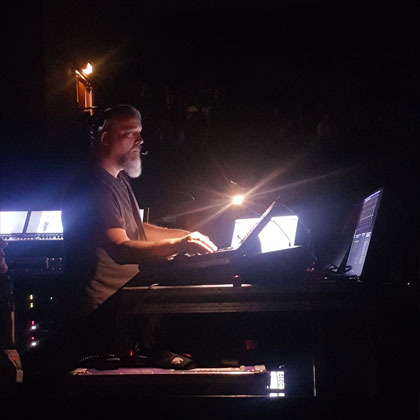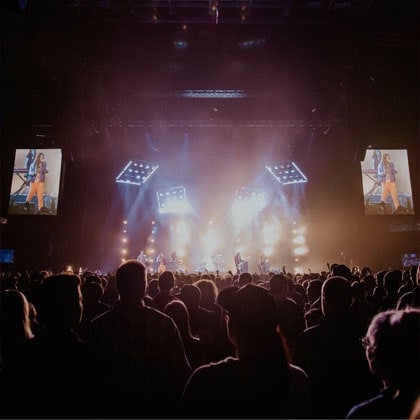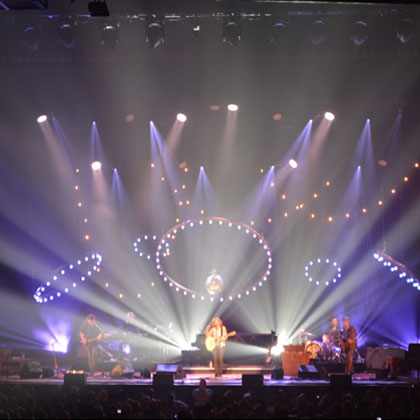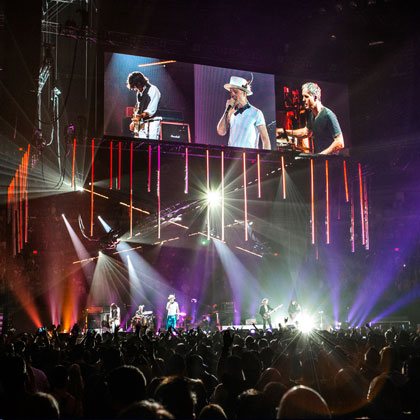PHOTO CREDITS: ©Brent Clark, ©Gavin Smith, ©Shawn Lawless
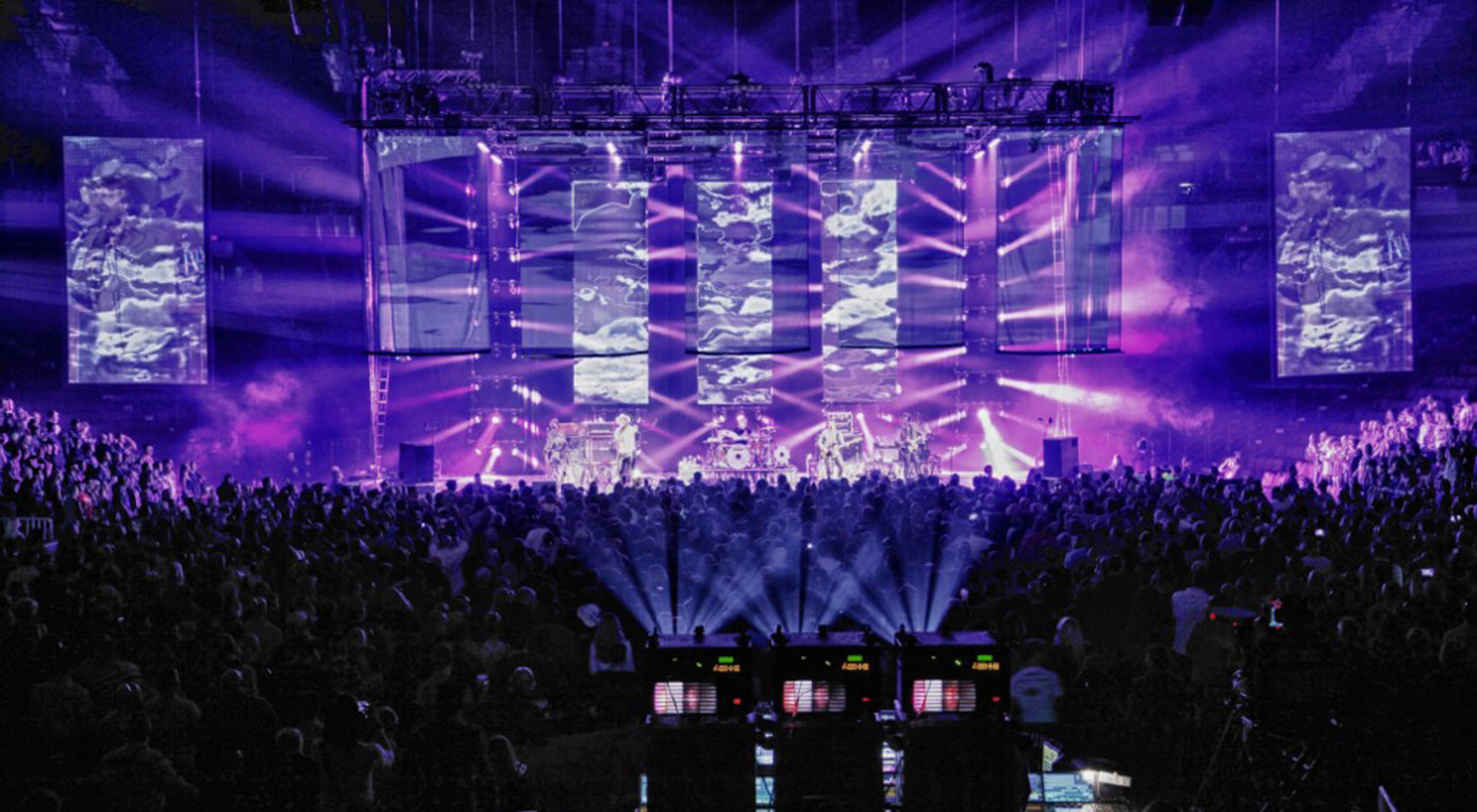
PHOTO CREDITS: ©Brent Clark, ©Gavin Smith, ©Shawn Lawless
Canadian lighting designer Brent Clark first began dabbling in lighting for bands as a teenager. He went on to study the art of theatre lighting at college, before building an enviable career in live music. Over the past 35 years he has earned his position as one of Canada’s most sought-after designers, with clients including The Tragically Hip, Glorious Sons, Our Lady Peace, Avril Lavigne, Sarah McLachlan, Barenaked Ladies and Stereophonics. His lighting design for The Tragically Hip’s final concert, broadcast by CBC as A National Celebration and watched by 11 million viewers, won him a Canadian Screen Award.
Where and when did your interest in lighting begin?
Probably just as I started High School, when I was about 13 or 14. I started working for a buddy’s band, doing lighting or whatever. I think my first paid gig was when I was 14. I got like 20 bucks and some beer. I thought it was great.
I got the music bug very early on. My older brother and brother-in-law both worked in the industry with some bar acts around town, so I was always intrigued with it. And there was a band that used to rehearse beside my house. They were about eight years older than me and I thought they were so cool, these old guys with long hair – or what I considered to be old guys . . . they were probably like 15 or 16.
I would sit in my room and listen to radio stations from the US and Canada - all this really cool music that was coming in at that time in the early 70s. It’s kind of come full circle now, because I remember sitting in my room listening to Steely Dan, and this past year I got to do a bunch of shows with them in the US. That was a lot of fun.
When did you first realize that it might be a career, and what did you envisage at that point?
In High School, I was lucky enough that our school had an actual working theater, so I got involved with that and at the weekend they would have touring ballet companies and stuff come in, and I worked on their crew for a lot of those shows. Getting paid for that made me think I could maybe make a living doing it. Then when I went to college I did a minor in lighting design with a major in scenic painting, it was clear there was a living. I knew in theater you’re not going to get rich, but it was still very rewarding.
Theater school was a baptism by fire. We did classes from 8.30 till about 5.00 every day, and then we did productions at night. There was a high attrition rate – by the end of the first semester we’d lost about half the class. That’s where it was driven into me that if you’re not 15 minutes early, you’re late. If you were late once, you got a warning; if you were late twice, you got kicked out.
At that point, were you thinking about a career in theater, or did you see it as a step towards lighting for live music?
I always wanted to do live music – I looked at this as like a stepping stone. You come out of that and think you know everything – then I spent four or five years driving a truck around Canada and the US, playing clubs and stuff. Then you really start to learn what it’s about! It was like starting over.
What did your study of theatre lighting give you?
I learned how to create moods, how to use lighting to reflect what was happening on the stage. It was about how to figure out what it was you’re trying to get across, as opposed to how many spinny lights you can point into the crowd. I found it very useful and I use it to this day. I try to approach all my designs with a sense of theater and dramatics. I had a great lighting design teacher who taught us how to convey emotions, color theory, lamp placement, whether one light will work in a situation . . . I draw on that all the time. I’m very grateful for that background.
Looking back, were there key pivotal moments that changed or influenced the direction of your career?
I’ve worked for a few artists that wanted me to push the norms of what is a rock show. Two of my major influences were the Canadian bands Our Lady Peace and The Tragically Hip. Both wanted to do something that was not conventional, and I loved that. They weren’t afraid to take a chance.
What have been your career highlights? What has given you the biggest buzz and why?
I try to go into everything with that kind of mindset – that either this is going to be the greatest thing that I’ve done, or that people are finally going to find out that I don’t know what I’m doing! I love the work and it still gives me shivers every time the house lights go down. There have been a lot of moments, but if I had to pick one it would be the last tour for The Tragically Hip - the last show was something I am very proud of. It was broadcast live to the country without a filter. It was the last show the band would ever do, because the lead singer, Gord Downie, had terminal brain cancer. It was an amazing show, so full of emotion. It will never be repeated. When you’re sitting there and you see the Prime Minister of your country rocking along with the band, you think, well, this is never going to happen again.
Then there’s Barenaked Ladies - we’ve done some great Canada Day celebrations, and they’re so much fun. The Stereophonics is always a challenge, and I really like that. Every tour with them is a highlight. I consider the last tour to be the best work I’ve done. It always leads me to challenge myself to do better the next time around.
Who have been your mentors and personal inspirations along the way?
Gord was very much an inspiration to me, him and Raine Maida, the lead singer of Our Lady Peace, because they always try to push you to do something different. I always appreciated the fact that they were willing to push the boundaries, be it musically, or visually. Being in their circle, and listening to how they create, really opened my eyes - things don’t have to be ‘normal’. Then my lighting design teacher from college, Doug Rathbun, he was awesome.
You’re in your fourth decade of doing this professionally – what has changed most significantly in that time, for better or worse?
I love this question. It has to be the advent of computers. They’ve made it much more easy to run shows, and to correlate information and all kinds of stuff, but coming from my background of live, and throwing faders . . . I think they’ve taken some of the human side out of it. I totally understand that you need timecode for those big and intricate moments, but I think the technology can become a crutch. I see a lot of very smart, intelligent people who get very involved in what the consoles can do, but don’t bother to look up at what’s happening on stage.
What causes you most frustration about the lighting business?
I think it’s that there are still a lot of people who don’t treat it as a business. People don’t take what we do seriously. You’ll get calls saying, ‘can you come and do this, and can you do it for this amount?’ My standard line has gotten to be, ‘Do you argue with your plumber when he shows up to fix your pipes?’ We provide a service and I get so tired of arguing about fees. You say, ‘Look at the body of work you’re going to get’. And they say, ‘But we can get X for half,’ so you say, ‘Then go and get X for half’!
What’s the single best piece of advice you’d give to someone wanting to follow your career path?
Don’t be afraid to work for it. Get dirty, pull cable, learn how everything works, not just the desk. If you can, go work for a rental house in the shop, prep rigs, learn how things go together and why. Take a tour where you are the third or fourth electrician. Always learn and ask questions.
How do you think of yourself, and how do you describe what you do, in terms of ‘art’ and ‘tech’?
I’m kind of a mixture of the two. I see it as being an artist first, who understands how things bolt together, and the constraints. And with that you make the art. It can be very constricting, especially if you’re working on a budget.
Do you think you have a ‘style’ of lighting? If so, how would you describe it?
Yes I do. ‘Asymmetrical symmetrical’ is what I call it. I love asymmetrical designs, but I also like taking a symmetrical design and making it asymmetrical in the programming. Asymmetry to me is beautiful – I like the broken-ness of it, it’s about space. It’s very easy with an asymmetrical rig to create space, whereas with a symmetrical rig you’re kind of limited, I think. I know the OCD people out there go nuts when they see my shows, but . . .
What’s Brent Clark’s lighting design rule number one?
Don’t be afraid to try anything. If someone says, ‘I want to try this with one light’, I’m like ‘OK, let’s give it a shot’. Or like with the last Stereophonics tour, where we did the first song under houselights – OK! I’m not afraid to try anything when it comes to design – I’m up for the challenge of how to make it work.
Successful show production depends on collaboration, which requires great communication. How do you ensure that runs as effectively as possible?
I just try to be as open with everyone as I can, and I’ll take input from almost anyone. Before we start I’ll try to find out what the communication lines will be, whether there’s a design brief, if we can have a conference call to discuss what’s needed. Then, once the tour’s out I try to talk to everyone once every few days to make sure they’re still happy, or if they want a change.
Sometimes you can’t talk to the artist – or someone doesn’t want you to talk to the artist – and that’s when you can end up with 18 or 20 revisions of your design, because you’re not getting to the person in charge. Then, when you finally get to talk to them, after a 10-minute phone conversation, it’s done. So it’s most effective to talk to the artist who has the vision – or to whoever has the vision – first, rather than a third party. There are times when people want to shelter the artist, which is fine, but if you’re hiring me to provide a service, then let me provide that service. I’m not here to get a selfie.
What traits do you admire most in the creatives you collaborate with?
I like the fact that people see things from a different angle to you, and you think, ‘yeah, I never really thought of it that way’. That’s what I like about working with Kelly Jones of the Stereophonics – it’s really interesting to get his take on things, and with the whole band – they’re awesome. That to me is always fun. I admire that people can look at it from a different point of view.
Where do you find inspiration for your designs?
A lot of the time it’ll come from the band’s artwork. If there’s a record out, or a theme, I’ll start Googling images and ideas. We used a lot of Pinterest on the last tour, building picture walls and things like that. I also studied architecture a bit at school, and I love the flow of buildings. I’ll get ideas wandering through a different city, taking photos. And I love to visit art galleries to see how painters capture the lighting, and perspective. I try to pull ideas from anywhere!
How does social media affect how you approach a design, and how aware you need to be of lighting for camera?
I’m very aware of the whole Instagram thing. I try to strike a good balance with that. With Stereophonics, they don’t like a lot of front-light, so I try to use floor lights from an angle and create shadows, so that it looks dark, but not dark – it’s a very fine line to walk! I like things to be kind of dark and moody, not just blasted with front-light. You can convey a lot with shadows. I light for my eye, then I’ll take pictures and see where I need to tweak things, how far I can push it. I try to light as well as I can for cameras, but I also have to take into account the guy who’s signing the checks.
Are there areas of lighting design that you haven’t yet tried but would like to?
I lit a touring musical recently, and it was interesting to go back into the theater world, where you can say to the actors, ‘Hey, you guys need to stop and stay where you are while we figure something out’. In rock and roll land, you don’t have the opportunity to do that! And I’m so used to having the people on the stage saying how they want it, whereas in the theater it’s the creative team. That was interesting, it’s been almost 30 years since I lit a theatre piece.
I’ve done lots of corporate events, car launches, some TV stuff. TV and film drives me crazy because of ‘hurry up and wait’ style of it. You’re sitting around for a couple of hours, then everything has to happen in 10 minutes. If anything, I’d like to do more theater.
Which other lighting designers do you particularly admire?
There’s a lot of them! I go back to Josef Svoboda, who was the king of theater lighting as far as I’m concerned. Marc Brickman - I watch the Pink Floyd Pulse DVD all the time and it still blows me away. LeRoy Bennett and Paul Normandale - anything those two do always amazes me. Cory Fitzgerald, Steven Douglas, Sooner Routhier, Kurt Wagner, Steve Baird – there are tons of them I’d put in the list. And Tim Routledge, Rob Sinclair, they always seem to be doing some really cutting-edge, cool stuff. And then there’s a bunch of new guys coming through like the Canadian Mike Herkimer, an amazing designer. There’s a lot of people I look up to!
What do you think are the most important attributes for a successful designer in your field?
I think to be open to whatever somebody has to say, to be ready to try new things, and not to pigeon-hole yourself into one aspect of design. Try something a bit different, push the envelope - if the budget allows.
What are the main performance characteristics you look for in a luminaire?
It depends on the project. For example, in the last ‘Phonics tour, we used the VL6500s and VL6000s, which were great and fitted perfectly into the design. Those big apertures, the chunky beam style was just awesome, and perfect for the job. To me, the VL6500 has become the signature part of the look. They remind me of the VL4 because you can get these weird funky colors out of them, and almost half-colors, and really interesting pastel colors. They were great. And the VL6000s – such a big, chunky, bright beam, which was awesome.
But I always try to pick the light that I need for the job – and not necessarily the newest and shiniest thing. I always have an idea of what I need going in, and I’ll try and push for that, but sometimes, again, budget comes up. A light might be perfect, but you can’t afford it, so you find something else. You have to pick your battles. Where do you want to spend your money? Sometimes you ask for the Ferrari and you walk away with the Fiat . . .
How far is low power consumption a consideration for you?
In these times, it’s always a consideration, but again it comes back to budget. I always try and keep it as green as I can. I love the LED choices we have now. The fact that you can get a white that’s not pink is great. And you can get a better red and the output has come a long way. I really love the new VL5 LED – that to me is a great light, the way it goes from tungsten to the pure whites and everything in between. I would have taken those on the last ‘Phonics tour, but when we were gearing up it wasn’t really available yet. I love that light, and I’m sure that every single TV show will have those on, just like with the original VL5. I worked for a company in Canada that was the Vari-Lite dealer, and that’s where I fell in love with the 5 – it was such a great light. Unique.
What’s missing from the LD’s toolkit? What would you like to see from manufacturers?
What I would like to see is a big version of a Fresnel, like a 10k with an LED source, which could change color, but with the fresnel lens on the front. And I’d like a small strip light that we could use as an outline for a stage, but also that would be bright enough to be a footlight. And a good LED PAR – I’m a sucker for lots of PAR Cans.
